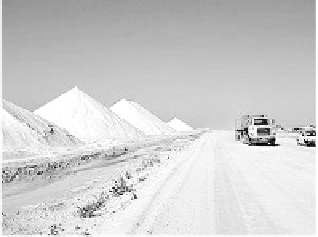Travel Reference
In-Depth Information
through the Treaty of Paris in 1816, they constructed Fort Oranje to
defend Bonaire from future attacks.
Salt of the Earth
Fifteenth-century Spanish
explorers were disappointed
to find that Bonaire didn't
have the natural resources
that made other Caribbean
islands desirable. But the
Dutch saw great economic
possibilities in the low land's
abundant supply of sodium
chloride.
Throughout history, salt has played an important part in food
preservation, and many civilizations have used it in religious cer-
emonies and as currency. At the time of New World exploration,
refrigeration had not been invented, and salt was vital for storing
fish and meat.
The Dutch West India Company was the first to draw vast
amounts of salt from Bonaire, beginning in 1623. Cargill, Inc., the
present operator, took over salt production in 1865.
Today, visitors are dazzled by the huge mounds of white crystals
piled near the solar salt works at Pekelmeer (Pickle Lake) on the
southern end of the island. Here, seawater is captured in the lake,
then moved through locks to condenser basins, where the water
evaporates through the power of the strong tropical sun and con-
stant easterly trade winds.
The salt crystals that are left behind are harvested, washed, and
tumbled in grates to remove contaminants. Before it is loaded into
container ships for transport to the US or other parts of the Carib-
bean, it is sun-dried for several months. The entire process takes
from one to five years, and most of the rough-grade salt is used in
water softeners or to melt ice from frozen roads.
The salt industry, Bonaire's major enterprise, began a sharp decline after
the abolition of slavery in 1862. The Dutch government divided the island
into five sections and auctioned them to businessmen who were interested
in lumber and ranching potential. Many residents, faced with unemploy-
ment or low-paying jobs, left to work in South America or on other Carib-
bean Islands.







Search WWH ::

Custom Search